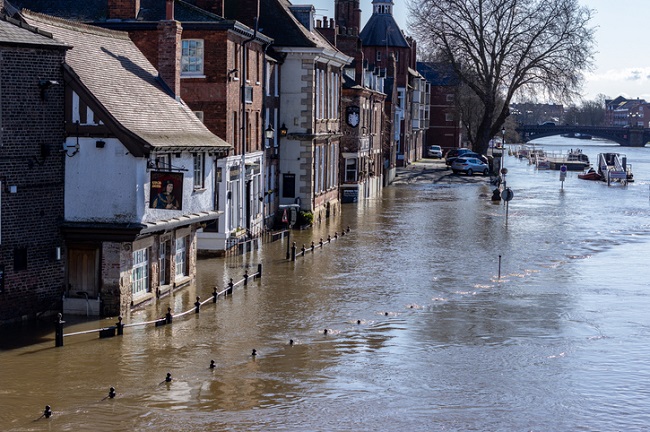What are flood defences
In 2018, the Environment Agency warned of more frequent flooding in years to come. The Agency has estimated that 5.2m homes and businesses in England are at risk of flooding and that about 700 properties are vulnerable to coastal erosion over the next 20 years.
A wide range of mechanisms are employed to prevent and control national flood risks. These mechanisms are known as flood defences, and they can apply to either rivers or coasts.

York is one city where flooding has become a bigger political issue.
Common river defences include levees, reservoirs and culverts. Coastal defences take the form of sea walls, revetments and groynes. A select number of structures, most notably dams, may fall into either category.
As governments attempt to mitigate the sustained effects of severe flooding, seen by many as a consequence of climate change, flood defences are becoming an increasingly potent political issue.


Types of flooding
Effective defence structures must be able to cope with the nature of a given flood. In general, the United Kingdom suffers the impacts of three types of flooding which occur under differing conditions.
Fluvial (or river) flooding is the result of a saturated river basin or lake. Following excessive rainfall or snowmelt, the water level rises and a river overflows onto the surrounding banks. Where shallow river channels span larger areas, fluvial floods can provoke widespread disruption. Oversaturated basins can also damage existing defences such as dams and dykes.
Pluvial (or rain water) flooding occurs independently of water bodies. Caused by a combination of heavy waterfall and limited draining capacities, pluvial flooding refers both to ‘surface water floods’ and ‘flash floods’. When urban drainage systems are overwhelmed, water escapes onto the nearby infrastructure causing surface water floods. Flash floods are caused by extreme rainfall or sudden water releases from dams or blockages. The strength of the surge can dislodge debris, branches, and trees, all of which are swept up in the flow. The rapid and unpredictable nature of flash floods leaves them among the most damaging.
Coastal flooding refers to the inundation of land close to the sea. This typically occurs when intense winds coincide with high tides, forcing the water onshore. The severity of storm surges is dependent on the strength and direction of wind, the level of the tide, and the nature of the land. Low-lying lands have been known to suffer devastating effects from tidal flooding.
Flood defences as a rising political issue
On an annual basis there are now regular flood event stories on the national news, all showing flood water to have caused substantial damage. The problems are often compounded by many of the victims having a lack of access to adequate flood insurance.
Each time, attention moves from sandbags and temporary flood defences, to the issue of flood risk management and the need for a wider flood defence system.
In 2015, Storm Desmond was alone said to cost the UK more than £5 billion.
In January 2016, the Environment, Food and Rural Affairs Committee of the House of Commons published a report on flood prevention in the UK. The report called for changes to the national flood management system, before launching an inquiry into how the Government might better control flood risks. The Committee received evidence on how to enhance existing flood defences, improve flood forecasting, and increase community resilience when flooding occurs.
The Committee’s report was framed by the rising occurrence and severity of storms as a consequence of climate change. National rainfall records were broken in the Winter of 2015-2016, and trends in weather patterns point to a persistent increase in flood risks.
In 2019, the Environment Agency warned that global temperatures could see a 4°C increase by 2100. It has been suggested that this would require a multi billion pound per year commitment to flood defences. In response to these climate warnings, the Government is already implementing new strategies to address the social, economic, and environmental impacts of flooding.
In October 2021, an investigation by the Guardian newspaper claimed that a third of England’s most important flood defences are in private hands, with more than 1,000 found to be in a poor state and some at risk of “complete performance failure”. The Labour Party has called for flood defences which are privately owned, and considered critically important to the protection of the public, are properly inspected and maintained.
The government’s approach to flood management
A policy statement published in July 2020 set out the government’s flood management plan for the 2020s. This long-term plan outlined five key commitments aimed at reducing and responding to the UK’s rising flood risk.
This plan also sits in the context of the government’s 25 Year Environment Plan, published 2018, which stresses that future policy decisions need to take into account the effects of climate change.
The plan is set to deliver flood and coastal defences that aim to prevent as much as £32 billion in economic damage. Its primary policy objects cover five areas:
1. Upgrading and expanding existing flood defences and infrastructure
For example, 2020 improvements to the Boston Barrier floodgate in Lincolnshire raised its height by one and a half metres compared to the 2013 flood levels. The total project cost was around £100 million, yet is thought to have reduced flood risk for 14,000 homes and 800 businesses.
2. Managing the flow of water to reduce flood risk
For example, in 2018, the Government published the Surface Water Management Action Plan to improve understanding of surface water risks. £4.7 million has been invested specifically in improving surface water mapping and modelling.
3. Harnessing the power of nature to not only reduce flood risk, but deliver benefits for the environment, nature, and communities
In the 2020 Budget, the Government announced £640 million for a Nature for Climate Fund to boost planting of trees and peatland restoration in England.
4. Better preparing communities for when flooding and erosion does occur
Following the 2019/20 winter floods, a series of recovery schemes were established to support those most severely impacted by the floods. These include the Farming Recovery Fund and the Property Flood Resilience Recovery Support Scheme.
5. Ensuring that every area of England has a comprehensive local plan for dealing with flooding.
The Government pledged to reform local flood risk planning by 2026, so that each area of England has a more strategic plan driving long-term action.
Current Public spending on food defences
£5.2 billion is to be spent on around 2000 new flood and coastal defences. This is intended to protect some 336,000 properties in England by 2027. The government has claimed this represents a doubling of the amount invested in flood and coastal defence programme in England in the next six years.
£200 million is being invested in innovative projects such as sustainable drainage systems and nature-based solutions. These will reduce the impacts of flooding in high-risk 25 areas.
£170 million is to be spent to accelerate work on ‘shovel-ready’ flood defence schemes intended to begin construction in 2020 or 2021.
- The National Audit Office has said thatthe Environment Agency’s plan to beef up England’s flood defences was being undermined by a lack of coordination between the various bodies tasked with maintaining them.
- The government has said that it will publish a roadmap by the end of 2022 to further accelerate take-up of property flood resilience measures, including through the implementation of the changes to the Flood Re scheme. The joint government and industry Flood Re scheme was designed to help households at high flood risk access affordable insurance.
- The Flood Re scheme is designed to allow insurers to help flooded households to make their homes more resilient to future flooding using products such as air brick covers, flood doors and flood resistant plasterboard – and benefit from discounted insurance premiums if they have resilience measures installed.
Notable Quotes
“Last winter I saw for myself the misery and upheaval that flooding can bring to lives and livelihoods and I said we would do more to help people.” – Prime Minister, Boris Johnson, 2020
“The devastating impacts of last winter’s flooding were an important reminder of the need to continue to invest and accelerate action to reduce the impact of flooding on our communities.” – Environment Secretary George Eustice, 2020
- “For every £1 spent improving protection from flooding and coastal erosion, we avoid around £5 of property damages. The long-term commitments announced today will make homes, businesses and infrastructure more resilient to the accelerating impacts of the climate crisis”….”“Many communities are all too familiar with flooding, and now the risk is increasing for others too. The Environment Agency is champing at the bit to deliver on the Government’s investment with better, and greener, flood schemes. Detail about how we will do this is set out in our strategy.” –Emma Howard Boyd, Chair of the Environment Agency:
Statistics
* The Environment Agency predicted in 2019 that for every person who suffers flooding, about 16 more are affected by loss of services such as power, transport and telecommunications.
* In 2020, the Environment Agency estimate that some 5.2 million homes in England were at risk of flooding.
* The Met Office forecasts that intense rainfall associated with severe flash flooding could become almost five times more likely by the end of this century.
* By the 2080s, up to 1,800 schools could be exposed to ‘significant likelihood’ of flooding (a greater than 1 in 75 annual chance). [Source – Energy and Climate Intelligence Unit]
* Along the English Channel coast, the sea level has already risen by about 12cm in the last 100 years We can expect a further 11-16cm of sea-level rise by 2030. This equates to 23-27cm of total sea-level rise since 1900. [Source – Energy and Climate Intelligence Unit]
* According to a UK Climate Change Risk Assessment report in 2017, it was predicted that 1.8 million people are living in areas of the UK which are at significant risk of flooding. Taking climate change into account, this figure is projected to rise to 2.6 million by the 2050s under a 2°C scenario and 3.3 million under a 4°C scenario, assuming a continuation of current levels of adaptation and low population growth.










